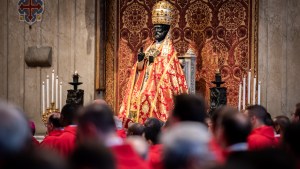During the recent Synod of Bishops closing Mass, St. Peter’s Basilica was abuzz with the unveiling of the newly restored baldachin after nine months of dedicated restoration work. While the magnificent bronze canopy over the tomb of St. Peter attracts much of the public’s attention, the Altar of the Chair, at the far end of the basilica, provides another compelling focal point – intimately tied to the origins the Church.
(See here the before and after of the baldachin.)
The Altar of the Chair, known as the Cathedra Petri (literally, “Peter’s Chair”), is a beautiful Baroque masterpiece. But it is also more than that. It is a visual summary of the Church’s mission to spread the Gospel – carried out throughout history, as sustained by the Successors of St. Peter, the popes.
Made by Gian Lorenzo Bernini between 1657 and 1666, this monumental work combines architectural elements with theological narrative in a striking display. Located in the apse of the basilica, the altar features an imposing bronze throne that surrounds a much smaller, antique wooden chair. According to tradition, this smaller chair was once used by St. Peter himself when he taught the faithful.
Bernini’s vision for the Altar of the Chair was to visually capture the presence of divine wisdom. Above the throne, a sculpted vision of the Holy Spirit as a dove emerges from a burst of heavenly light, framed by clouds and adoring angels – symbolizing divine guidance throughout history. This vivid imagery reinforces the altar’s role as a sacred reminder of the Holy Spirit guiding Peter’s Successors in their role of teaching and interpreting the Word.

Beneath this awe-inspiring scene sits the monumental bronze chair, decorated with panels depicting Gospel scenes relevant to the papal mission. These intricate details illustrate themes of pastoral care, humility, and authority – all aspects of Christ’s mandate to Peter. “Feed my sheep,” “wash one another’s feet,” and “I give you the keys of the kingdom” (Jn 21:17; Jn 13:14; Mt 16:19) all remind the viewer of the nature of leadership in the Church: a call to service, stewardship, and divine commission.
The figures of four Doctors of the Church (Sts. Ambrose and Augustine from the West and Sts. Athanasius and John Chrysostom from the East) frame the throne. Their figures seem to support the chair with reverent gestures, a symbol of the unity of Christian traditions. This unity is further emphasized by Bernini’s depiction of light (an integral part of the altar’s design), underscoring his dedication to creating a scene where heaven seems to meet earth, drawing the viewer into a world animated by the Spirit of God.
As told by Vatican News, from October 27 through December 8 visitors will have the rare opportunity to view the original ancient chair at the foot of the high altar before it is returned to its bronze setting. This fleeting glimpse of the Altar of the Chair brings to life the enduring mission of the Successor of Peter to lead, serve, and inspire God’s people.




